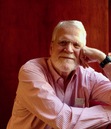Mark Scott Smith's Blog: Enemy in the Mirror, page 82
February 15, 2018
Interstate Bus Segregation
In June 1946 the U.S. Supreme Court struck down a Virginia law requiring racial segregation on commercial interstate buses as a violation of the commerce clause of the U.S. Constitution. The appellant Irene Morgan, riding an interstate Greyhound bus in 1944 had been arrested and convicted when she refused to give up her seat to a white person.
Most southern states refused to acknowledge the ruling and continued to practice segregation in almost all parts of society. In-state bus segregation continued well into the 1950s.
The post Interstate Bus Segregation appeared first on Enemy in the Mirror.
February 12, 2018
Chinese Civil War Resumes
The civil war between Chinese Nationalists and Communists, begun in 1927, was put on hold during the fight against Imperial Japan in WWII. After the Japanese surrender in August 1945, the Chinese Communist Party and the Nationalists agreed to peace talks and a ceasefire. In July of 1946, however, the Nationalist (Kuomintang) leader Chiang Kai-shek launched a large-scale assault on Communist territory in North China.
The Nationalists controlled the most territory in China and received American and international support.
The Communists (under the leadership of Mao Tse-Tung) were well-established in the north of the country, had lost fewer men in the war against Japan and received support from the Soviet Union.
Hyperinflation during this civil war caused misery and starvation for millions of Chinese. Historian Michael Lynch wrote: “In 1940, 100 yuan bought a pig, in 1943 a chicken, in 1945 a fish, in 1946 an egg, and in 1947 one third of a box of matches.”

Unemployment, crime and black markets emerged. Conscripted Nationalist army troops raped and looted the civilian population, and mutinied or deserted in large numbers. Chiang Kai-Shek’s government appeared rife with corruption and dictatorial leadership.

The Communist People’s Liberation Army, on the other hand, appeared to be winning the propaganda war. Communist political philosophy (including anti-imperialism, raised proletarian consciousness and land reform) helped instill grassroots support among the Chinese populace.
During the war, which continued until 1949, both the Nationalists and Communists carried out mass atrocities, killing millions of non-combatants.
Estimated deaths in the Chinese Civil War 1927-1945 = 8,000,000–11,692,000
The post Chinese Civil War Resumes appeared first on Enemy in the Mirror.
February 8, 2018
Life in Postwar America
Cost of Living 1946
Average Cost of new house $5,600.00
Average wages per year $2,500.00
Cost of a gallon of Gas 15 cents
Average Cost of a new car $1,120.00
Worlds First Electric Blanket $39.50
Men’s Ties $1.50
Watermans Pen $8.75
Chicken 41 cents per pound
Coffee 85 cents for 2 pound bag
Doughnuts 15 cents per dozen
Eggs 64 cents per dozen

The post Life in Postwar America appeared first on Enemy in the Mirror.
February 5, 2018
America in 1950
(I’m jumping my own timeline here – we’ll get back to 1946 with the next post)

Check out my PINTEREST board ~ America in 1950
Any corrections (sometimes it’s hard to pinpoint 1950 exactly since most search engines want “the 50s”) or suggestions for additional items would be most welcome.

A Marine bids farewell to his wife and two daughters as elements of the famed Second Marine Division leave for the West Coast – Circa August 1950. Published in “All Hands” magazine’s March 1951 issue.
The post America in 1950 appeared first on Enemy in the Mirror.
Philippine Independence
The Philippines was colonized by Spain in the 16th century. In 1898 Filipino rebels led by Emilio Aguinaldo and U.S. troops ousted the Spanish in the Spanish-American War. However, Philippine independence was thwarted when the U.S. formally annexed the country as part of its peace treaty with Spain.
In 1899 Filipino rebels fought with U.S. troops in Manila. Thereafter, the rebels, unable to win in open battle, pursued guerrilla warfare. >60,000 troops American troops were then sent to the Philippines to pacify the population. In 1901 U.S. forces captured Aguinaldo who promised allegiance to the United States and an end to the rebellion. Nevertheless, many rebels fought on. During the next year, U.S. forces gradually pacified the Philippines.
In one infamous example of ruthless suppression, U.S. forces under the command of General Jacob Smith, retaliated against the rebel massacre of a U.S. garrison by killing every male older than 10 years of age (along with may women and young children) on the island of Samar.
>4,000 Americans and >20,000 Philippino insurgents were killed along with an unknown number of civilians during the insurrection.
In 1935, the Commonwealth of the Philippines was established with U.S. approval, and Manuel Quezon was elected the Commonwealth’s first president.
During the Japanese occupation of the Philippines from 1942-45, a highly effective guerilla campaign by resistance forces controlled sixty percent of the islands, mostly jungle and mountain areas. General Douglas MacArthur supplied them by submarine, and sent reinforcements and officers.
On July 4, 1946, full independence was granted to the Republic of the Philippines by the United States.
The post Philippine Independence appeared first on Enemy in the Mirror.
February 1, 2018
Bikini Bathing Suit
In the 1930s, European women wore two-piece bathing suits consisting of a halter top and shorts with some midriff visible — the navel was always hidden.
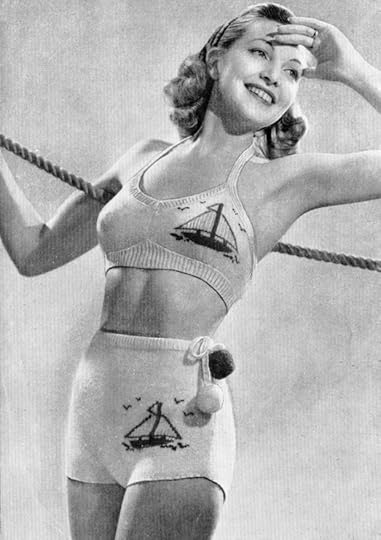
https://i.pinimg.com/originals/21/7a/...
On Jul 5,1946 the bikini bathing suit, created by former civil engineer Louis Reard, made its debut during a fashion show at the Molitor Pool in Paris. Model Micheline Bernardini wore the skimpy two-piece outfit, its name correlated with the July 1 American atom bomb test on Bikini Atoll.
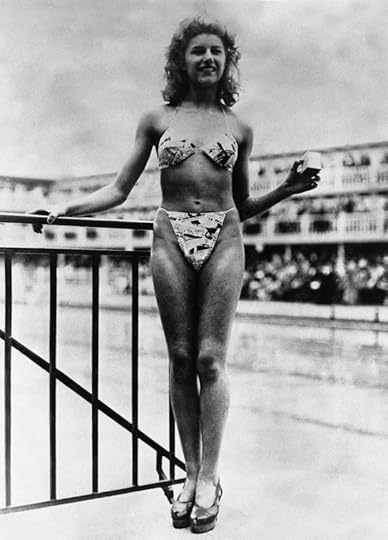
blogspot.com
The post Bikini Bathing Suit appeared first on Enemy in the Mirror.
January 29, 2018
Bikini Atoll Atomic Bomb
On 1 July 1946, the United States conducted Operation Crossroads Test Able, the first of a series of 67 American nuclear tests after WWII. The explosion took place at the Bikini Atoll lagoon, situated in the Marshall Islands in the Pacific Ocean.
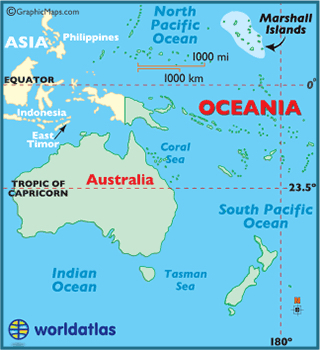

The bomb, almost identical to the weapon used against Nagasaki in August 1945, was detonated 158 meters above sea level with a yield of 23 kilotons. The blast sunk five of 78 vessels anchored in the lagoon and seriously damaged 14 others.
Radiation danger at the time was seriously underestimated and U.S. Marines boarded the vessels shortly after the explosion to attempt decontamination by scrubbing the decks.
Additionally, a third of 57 animals placed on the decks of the targeted ships died from the blast or lethal radiation. This animal sacrifice elicited public opinion against nuclear testing for the first time.
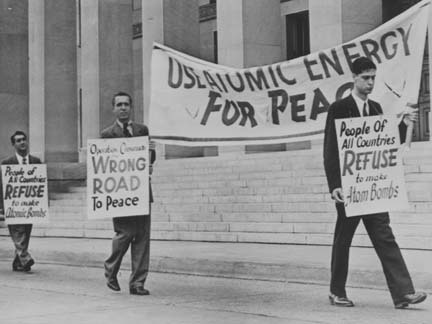
http://www.ajmuste.org/November2006ap...

The post Bikini Atoll Atomic Bomb appeared first on Enemy in the Mirror.
January 25, 2018
Harry Truman
Harry S. Truman (1884 – 1972) was the 33rd President of the United States from 1945–1953. A WWI veteran, Truman assumed the presidency upon the death of Franklin Roosevelt in April 1945. Some of his accomplishments include implementing the Marshall Plan to rebuild the economy of Western Europe, integrating the armed forces, promoting establishment of the Truman Doctrine and NATO as a bulwark against Soviet and Chinese communist expansion, and intervention in the Korean War.
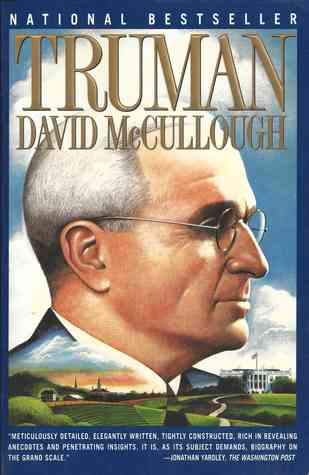
‘Truman by David McCullough ,the two-time Pulitzer Prize winner for books about John Adams and Truman, is an excellent finely-detailed biography of Harry Truman’s entire life.
The post Harry Truman appeared first on Enemy in the Mirror.
January 22, 2018
Dr. Benjamin Spock
Although apparently narrated by a robot, this video neatly summarizes the essence of Dr. Benjamin Spock’s advice to post-WWII parents.

The Common Sense Book of Baby and Child Care, published in 1946, sold over 50 million copies by the time of Spock’s death in 1998. The book has also been translated into 39 languages.
Prior to Spock’s book, child care experts recommended rigid schedules for the feeding and toileting of infants and cautioned parents not to show excessive affection for their children. In contrast, Spock recommended flexibility in child-rearing and the recognition that each child was an individual.
Influenced by his own psychoanalytic training, Spock emphasized that childhood behavior and motivation was variable at each stage of development, and parents should make their own decisions, rather than follow the authoritative advice of presumed experts regarding how to raise their children. Above all, he urged parents to have confidence in their abilities and trust their own common sense.
The post Dr. Benjamin Spock appeared first on Enemy in the Mirror.
January 18, 2018
North & South Korea
This rapid-fire video is an excellent summary of Korean history since the 19th century.
The division of Korea between North and South occurred after WWII, ending the Empire of Japan’s 35-year rule over Korea in 1945. The United States and the Soviet Union occupied two parts of the country, with the boundary between their zones of control along the 38th parallel.
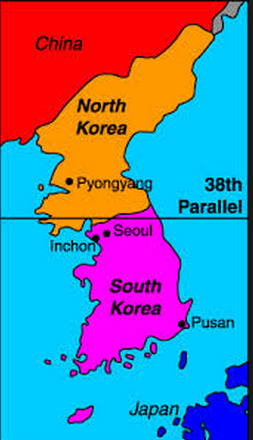
With the onset of the Cold War, negotiations between the United States and the Soviet Union failed to lead to an independent, unified Korea. In 1948, UN-supervised elections were held in the US-occupied south only. The anti-communist Syngman Rhee won the election while Kim Il-Sung was appointed as the leader of North Korea by Joseph Stalin.
This led to the establishment of the Republic of Korea in the south, which was promptly followed by the establishment of the Democratic People’s Republic of Korea in the north. The United States supported the South, the Soviet Union supported the North, and each government claimed sovereignty over the whole Korean peninsula.

Are North and South Koreans really one people who have been arbitrarily divided by external political forces?
Here is one opinion: “The political events forcing Koreans to live in either the North or South of the country were not only brutal but destroyed the previous cultural and linguistic homogeny of a people that were previously part of a single empire and living as family members, friends, neighbours or colleagues.” – Commisceo Global (a cross-cultural blog)
The post North & South Korea appeared first on Enemy in the Mirror.
Enemy in the Mirror
I began by posting events around the turn This website www.enemyinmirror.com explores the consciousness, diplomacy, emotion, prejudice and psychology of 20th Century America and her enemies in wartime.
I began by posting events around the turn of the 20th century as I was researching my first novel about the Pacific War. I continued through WWII for my second novel about the Battle of the Atlantic. Now I am beginning to look at the Cold War as I gather information for my next novel about the Korean War. ...more
- Mark Scott Smith's profile
- 7 followers


